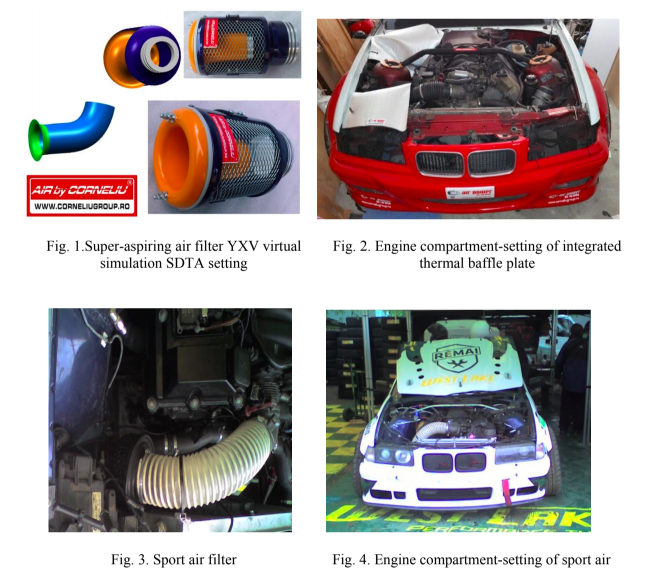The case study was aimed towards the cars from Drift competitions due to the conditions and to the specific dynamics of drifting which leads to a poor air circulation through the engine compartment destined for cooling, emphasizing in this way the heat dissipation.
The thermal radiations and the hot air from the cooling radiator of the engine additional heat the air filter and the intake manifold. The absorbed air is also heated minimizing its density, and the engine performances are fewer during the warm season.
The temperatures of the air filter and the intake manifold vary, in this case, between 60…85 ̊C, depending on the speed of the vehicle.[3]
2. CONDITIONS AND MEASUREMENTS
Comparative measures have been made on the engine compartment focusing on the exterior surfaces of the air filter, intake gallery and on the heat sources (the engine cooling radiator, intercooler, engine and oil cooling radiator).
Two competition cars were studied with identic engines, with cilindrical capacity of 4,4l V8, BMW each equiped with a different air filter, as it follows:
-1st alternative (fig. 1; fig. 2) super-aspirating air filter YXV, dynamic system of air
transfer (SDTA) and an integrated thermal baffle plate;
-2nd alternative (fig. 3; fig. 4) sport air filter [4].
2.1.Super-aspiring air filter YXV
The super-aspirating air filter YXV (fig.1) is multifunctional, the technical problem which it solves represents the intake and the growing of the air speed with the aim of increasing the filtrated air volume available for the feeding of the internal combustion engine [1].
2.2.Dynamic system of the air transfer – SDTA
The dynamic system of the air transfer (fig. 1) reffers to a device destined to the air
transfer outside the engine compartment on the sport air filter and classic for the obtaining of
a laminar flow, concentrated on the air flux and on its temperature drop, for a increase of
volume efficiency of the internal combustion engine [1].
2.3.Integrated thermal baffle plate
The technical problem which the integrated thermal baffle plate solves (fig. 2) is the
protection of the intake manifold and of the air filter from thermal radiations that come from
the engine cooling radiator and from the engine itself[1].

3.THERMOGRAPHIC MEASUREMENTS OF THE HEAT FLOW DISSIPATION
The comparative temperature measures from the engine compartment are presented next (overview), from the exterior surface of the air filter and the intake gallery, for both alternatives above mentioned. Using the thermographic camera the areas influenced by the thermal transfer can be emphasized as a result of the heat dissipation through the engine compartment.
The measures were made when the drift cars left the track
The absorbed air is heated minimizing its density, the engine performances drop especially in the warm season, the registered power loss are up to 20%.
The temperatures of the air filtres and of the intake gallery are different, in this case, between 60… 85 ̊C, depending on the speed of the vehicle [3].
The heat flow dissipation is dependent on the following constructive parameters, on the air filter and on the intake gallery:
-used materials
-exterior architecture and surface
The obtained results are presented in the figure 8.
3. FINAL RESULTS AND CONCLUSIONS
At the end of the measurements one can point out the fact that the car equiped with the super-aspiring air filter YXV, dynamic system of air transfer (STDA) and integrated thermal baffle plate (alternative 1) presents low temperatures in the air filter area and on the exterior surface of the intake gallery in comparison with the same model equiped only with the sport filter (alternative 2) (figure 8).
In conclusion, through the implemented solutions in the case of the 1st alternative, the intake air in m.a.i. has a temperature up to 30% less.
The effect of reducing the intake air temperature lead to an improvement of the efficiency of the motor cylinder filling, avoiding in this way the appearance of the overheating phenomena of the m.a.i. which is frequently encountered in engines in the case of drift cars.
Written by: Lector Eng Dr.Corneliu BIRTOK-BĂNEASĂ
( Associated Authors: Politehnica University of Timisoara, faculty of Ingineering Hunedoara)